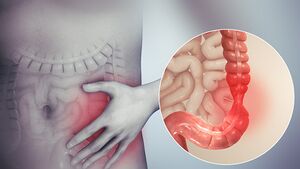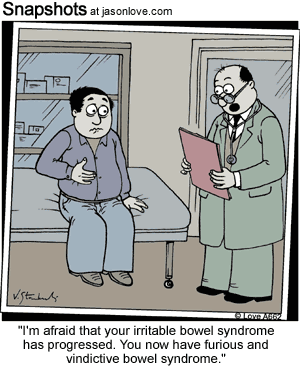Irritable Bowel Syndrome
Original Editors - Mary Page from Bellarmine University's Pathophysiology of Complex Patient Problems project.
Top Contributors - Mary Page, James Jolly, Admin, Hannah Wempe, Lucinda hampton, Kim Jackson, 127.0.0.1, Elaine Lonnemann, WikiSysop, Dave Pariser, Wendy Walker, Vidya Acharya and Manisha Shrestha
Introduction[edit | edit source]
Irritable bowel syndrome (IBS) is the most common disorder of the GI system, with symptoms predominantly including diarrhoea, constipation, or a combination of both. IBS is considered a functional disorder of motility in the small and large intestine, due to no detectable abnormality of the bowel [1]. IBS can also be referred to as nervous indigestion, functional dyspepsia, spastic colon, irritable colon, pylorospasm, spastic colitis, intestinal neuroses, and laxative or cathartic colitis[2].
Epidemiology[edit | edit source]
IBS is one of the most commonly diagnosed GI disorders with nearly 12 percent of patients who seek medical care in primary care practices being for IBS related complaints.[2][1]. Studies reveal a prevalence as high as 20%, dependant on the area of the world studied and the diagnostic criteria employed. In South America approximately 21% have IBS whilst in Southeast Asia at 7% have IBS.[3][4]
Etiology[edit | edit source]
IBS cause remains unknown, despite concerted efforts find its etiology. Probably multiple factors are at play. Of late a very common protozoan called Blastocystis sp. has been seen as a risk factor, although the mechanism through which it may cause IBS yet to be found.[3]
Characteristics/Clinical Presentation[edit | edit source]
GI symptoms associated with IBS are highly variable, normally intermittent and can include but are not limited to the following: [1]
- Painful abdominal cramps
- Constipation
- Diarrhoea
- Nausea and vomiting
- Anorexia
- Foul breath
- Sour stomach
- Flatulence
- Abdominal bloating
- White mucus in stool
Pain characteristics include a dull, deep discomfort with sharp cramps in the lower left quadrant of the abdomen. Abdominal pain normally occurs in the morning or after eating and is relieved by evacuation of the bowels[2]
Diagnostic Tests/Lab Tests/Lab Values[edit | edit source]
Because there are no physical signs or abnormalities associated with Irritable Bowel Syndrome, there are currently no definitive tests for diagnosis [2][5]. IBS symptoms are also seen in more dangerous bowel conditions doctors need to eliminate these before diagnosing IBS. Diagnosis is then usually based on patient history and two sets of symptom-based criteria:
- Rome III criteria—This criteria require the patient to have abdominal pain lasting at least three days a month in the last three months, associated with two or more of the following: [5] Improved pain with defecation; Altered frequency of defecation; Altered consistency of stool[5]
- Manning criteria—This criteria looks at the likelihood of IBS being present based on the following symptoms: Pain relieved by defecation; Incomplete bowel movements; Mucus in stool; Changes in stool consistency[5]
Additional tests: The doctor may recommend several tests, including stool studies to check for infection or malabsorption problems. Among the tests that you may undergo to rule out other causes for your symptoms are the following:
- Flexible sigmoidoscopy or Colonoscopy.
- Stool test
- Blood tests to check for Celiac disease [5].
Symptom-based (criteria-based) approaches can vary widely in their administration and interpretation from one practitioner to the next and have yet to be standardized over any one health profession [6]
Medical Management[edit | edit source]
Treatment is aimed at relieving abdominal discomfort, stabilizing bowel habits, and altering underlying causes of the syndrome. Lifestyle changes, especially dietary changes, medications, behavioral counseling, and psychotherapy have been advocated.
Since people with IBS can have a slower intestinal transit time, resulting in constipation, the use of fibre supplements such as polycarbophil (FiberCon), psyllium seed (Metamucil), and increased intake of water and other fluids is advised. There is also good evidence that antispasmodics and anticholinergics such as dicyclomine, hyoscyamine, and peppermint oil are effective in treating symptoms. Furthermore, antidepressants (specifically selective serotonin reuptake inhibitors and tricyclic antidepressants) have been shown to reduce abdominal pain and other IBS symptoms. Rifaximin, an unabsorbable antibiotic, has also shown marked improvement in the treatment of diarrhoea. Lastly, Loperamide can be taken to improve the frequency and consistency of bowel movements but does not affect other symptoms of the disorder [2].
Aimed at the theory of bacterial overgrowth, continued research on the effectiveness of probiotics on IBS symptoms shows that Bifidobacterium Infantis has some efficacy in symptom reduction, however, it is still unknown whether other probiotics are as effective.
A stress reduction program with a regular program of relaxation techniques and exercise in conjunction with psychotherapy and biofeedback training may be effective for some people. Behavioral therapy is focused on identifying and reducing or eliminating triggers and reducing negative self-talk. Hypnotherapy can give some control over the muscle activity of the GI tract and the gut’s sensitivity to stress and other influences [2].
Physical Therapy Management[edit | edit source]
Regular physical activity helps relieve stress and assists in bowel function, particularly in people who experience constipation. The therapist should encourage anyone with IBS to continue with their prescribed rehabilitation intervention program during symptomatic periods.
Therapists must be alert to the person with IBS who has developed breath-holding patterns or hyperventilation in response to stress. Teaching proper breathing is important for all daily activities, especially during exercise and relaxation techniques.
It is also important for therapists—specifically in the field of Women’s Health—to be aware of the correlation between abuse and GI disorders. Therapists can provide these patients with information regarding various resources that victims of abuse may find helpful.
Therapists can also treat the various conditions associated with IBS, such as fibromyalgia, chronic fatigue syndrome, temporomandibular joint disorder, and chronic pelvic pain, in attempts to decrease symptoms of IBS. The treatment of these conditions can further relieve stress, an associated trigger for IBS symptoms [2].
Dietary Management (current best evidence)
Eliminating foods that trigger symptoms is one of the most effective treatments for IBS. Common suggestions made my doctors include eliminating:
• High-gas foods—foods such as carbonated beverages, cabbage, broccoli, cauliflower, and raw fruits can contribute to bothersome bloating or gas.
• Gluten—this is still a controversial topic, however, some research shows that diarrhoea can be reduced by eliminating gluten from the diet.
• FODMAPs—recent research on IBS has focused on FODMAPs (fermentable oligo-, di-, and monosaccharides and polyols) which are a type of carbohydrate that includes fructose, fructans, lactose, and others. FODMAPs are found in certain grains, vegetables, fruits, and dairy products and people with IBS can benefit from a low FODMAP diet, which may be a trigger for their symptoms. [5]
Herbal tea, such as chamomile (Chamaemelumnobile), can be surprisingly effective due to its relaxation and gentle antispasmodic properties. Peppermint (Mentha piperita) and fennel (Foeniculum vulgare) are both antispasmodics as well as anti-inflammatories. Herbalists often recommend combining these three herbs to make a single dose of tea to soothe painful spasms and expel excess wind. Several clinical trials, as well as animal studies, which have shown the potential benefits of peppermint oil in IBS; while further studies illustrate a clear understanding of its mode of action on the gut. However, human studies of peppermint leaf are limited and clinical trials on the actual tea are absent [1].
Differential Diagnosis[edit | edit source]
Inflammatory Bowel Disease[edit | edit source]
- Ulcerative colitis - inflammation and ulceration of the inner lining of the large intestine and rectum.
- Crohn's disease - inflammatory disease that most commonly attacks the terminal end of the small intestine (ileum) and the colon. However, it can occur anywhere from the mouth to the anus.
Colorectal Cancer[edit | edit source]
The presentation of colorectal carcinoma is related to the location of the neoplasm within the colon and the stage of cancer. Early-stage signs and symptoms include rectal bleeding, haemorrhoids, abdominal/back/pelvic/sacral pain, back pain radiating down the legs and changes in bowel patterns. Advanced stage signs and symptoms include constipation progressing to obstruction, diarrhoea with copious amounts of mucus, nausea, vomiting, abdominal distention, weight loss, fatigue, dyspnoea, and fever[1]."
Case Reports [edit | edit source]
Drossman DA, Ringel Y, Vogt BA, Leserman J, Lin W, Smith JK et al. Alterations of brain activity associated with resolution of emotional distress and pain in a case of severe irritable bowel syndrome. GASTROENTEROLOGY 2003;124:754-761.
Medscape Article: Cash BD. A 32-Year-Old Woman With IBS: Clinical Outcomes and the Use of Antibiotics. Medscape Education Gastroenterology 2011.
Resources[edit | edit source]
World Gastroenterology Organization
Irritable Bowel Syndrome Self Help and Support Group
Irriitable Bowel Syndrome Treatment
International Foundation for Functional Gastrointestinal Disorders: About IBS
References[edit | edit source]
- ↑ 1.0 1.1 1.2 1.3 1.4 Goodman, CC, Snyder TE. Differential Diagnosis for phyical therapists: screening for referral. 5th ed St. Louis: Saunders Elsevier, 2013.
- ↑ 2.0 2.1 2.2 2.3 2.4 2.5 2.6 Goodman CC, Fuller KS. Pathology: implications for the physical therapist. 4th ed. St. Louis: Saunders Elsevier, 2015
- ↑ 3.0 3.1 Radiopedia Irritable Bowel Syndrome Available: https://radiopaedia.org/articles/irritable-bowel-syndrome?lang=us(accessed 28.1.2023)
- ↑ Patel N, Shackelford K. Irritable Bowel Syndrome.[Updated Jul 10]. StatPearls [Internet]. Treasure Island (FL): StatPearls Available from: https://www. ncbi. nlm. nih. gov/books/NBK534810/▪ Ringström, G., Störsrud, S., Lundgvist, S., Westman, B., & Simren, M.(2009): Development of and educational intervention for patients with irritable bowel syndrome: A pilot study. BMC Gastroenterology. 2020;9(10):1-9. Available: https://www.ncbi.nlm.nih.gov/books/NBK534810/(accessed 28.1.2023)
- ↑ 5.0 5.1 5.2 5.3 5.4 5.5 Mayo clinic. Irritable bowel syndrome. http://www.mayoclinic.com/health/irritable-bowel-syndrome/DS00106/DSECTION=prevention (Accessed 29 March 2017).
- ↑ Williams RE, Black CL, Kim HY, Andrews EB, Mangel AW, Buda JJ et al. Stability of irritable bowel syndrome using a roma II-based classification. Aliment Pharmacol Ther 2006;23:197-205.








